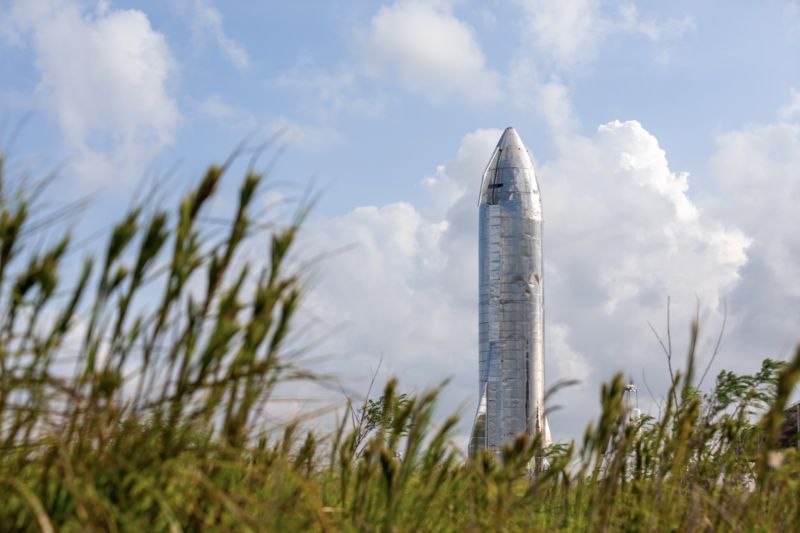
On Wednesday afternoon, SpaceX loaded nitrogen into a prototype version of its Starship vehicle. The exercise, at the company's facilities near Boca Chica Beach in South Texas, represented the first significant pressurization test of the vehicle fuel tanks.
About halfway during the process, however, some sort of failure occurred as the top bulkhead of the vehicle broke apart and went flying away. This was followed by a large, white cloud of smoke and vapor emanating from the interior of the vehicle, which eventually cleared to reveal a dented, but still shiny Starship. This was the same vehicle the company revealed in late September.
SpaceX sought to play down the accident, noting this was a "max" pressurization test to stress the system. No one was hurt, the company said, and it was not a serious setback in the development of the ambitious vehicle. The company's founder and lead technical designer, Elon Musk, later said on Twitter that this prototype had "some value as a manufacturing pathfinder," but that the flight design of the vehicle would be "quite different."
So what's the deal? Is this a catastrophe for SpaceX that dooms its Starship program? Or just a minor setback as the company suggests? The answer is probably closer to the latter.
Iterative is the way
The key to grasping why SpaceX can afford an accident like this is to understand its iterative design philosophy. Under this approach to the design of spaceflight hardware, the company builds vehicles, tests them, and flies them as quickly as possible. And if they fail, as often happens, SpaceX fixes them. This is especially true of the Starship program in which teams of SpaceX engineers in Texas and Florida are separately building prototypes of Starship to learn from them and then improve the design in subsequent versions.
The nomenclature SpaceX uses is "Mark," as in the vehicle the that was severely damaged Wednesday was Mark 1, with Mark 2 being built in Florida, and work already beginning on Mark 3 in Texas. It is possible this "Mark 3" vehicle will fly into orbit sometime in 2020.
RIP Starship Mk1. @LabPadre stream:https://t.co/CwiHPUf7D3 pic.twitter.com/SckLfdIhw3
— Chris B - NSF (@NASASpaceflight) November 20, 2019
This "fail early, fail forward" strategy allows a company to move more quickly and improve its design along the way. It also results in public failures, such as the all-explodey rocket Wednesday. This cannot exactly strengthen customer confidence in Starship, but given that failures are baked into the development process, it does not diminish Starship's overall prospects.
Brutal politics
For casual observers of spaceflight, this "iterative" design philosophy is very different from the much slower, linear design process used by traditional aerospace partners for large development projects. Under this more traditional process, a company or—historically, NASA—seeks to avoid the risk of a rocket failing before it is perfected. Years are spent designing and testing every component of a vehicle before it is assembled for a full-scale test. As a result the process is much slower and more costly.
During a visit to SpaceX's factory in Hawthorne, California, in October, NASA Administrator Jim Bridenstine said he welcomed SpaceX's design philosophy. "I like it being a part of the mix of our contract capabilities," Bridenstine said at the time.
It is easier for a company like SpaceX working on a self-funded project like Starship to do this than a government agency, noted Phil Metzger, a planetary scientist at the University of Central Florida. "You have to let people see you fail, and you have to push back when the critics use your early failures as an excuse to shut you down," he recently said. "This is why it is hard for national space agencies to adopt it. The geopolitics and domestic politics are brutal."
https://news.google.com/__i/rss/rd/articles/CBMiaGh0dHBzOi8vYXJzdGVjaG5pY2EuY29tL3NjaWVuY2UvMjAxOS8xMS9zcGFjZXgtaGFzLWxvc3QtaXRzLWZpcnN0LXN0YXJzaGlwLXByb3RvdHlwZS1pcy10aGlzLWEtYmlnLWRlYWwv0gFuaHR0cHM6Ly9hcnN0ZWNobmljYS5jb20vc2NpZW5jZS8yMDE5LzExL3NwYWNleC1oYXMtbG9zdC1pdHMtZmlyc3Qtc3RhcnNoaXAtcHJvdG90eXBlLWlzLXRoaXMtYS1iaWctZGVhbC8_YW1wPTE?oc=5
2019-11-21 14:39:00Z
52780442957918
Bagikan Berita Ini














0 Response to "SpaceX has lost its first Starship prototype—is this a big deal? - Ars Technica"
Post a Comment